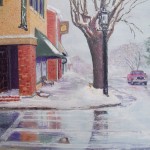
Manipulating acrylics on a surface can be interesting and rewarding, resulting in delightful effects by using such tools as various brushes, palette knife, old credit card, razor blade, and even an icepick, as well as, almost anything you can imagine that might give you an effect you wish to portray by scraping, scratching and abrading.
A palette knife is an excellent tool for scraping. You can use the tip for linear effects and broad sweeps can be made using the edge. Credit cards can be used creating very similar impressions. Razor blades are useful for acrylics on paper when you want to scrape down to the under painting or wish to use it for abrading.
Tip: It is best that scraping be done while the paint is wet and on a paper surface that can remain unsaturated for an extended period.
Tip: Acrylics dry quickly limiting the time during which scraping can be done successfully so, if scraping is attempted on gessoed canvas and panels, it works best with thick paint applications that will take longer to dry.
Scratching is another technique that an artist using acrylic paints can select to give a very similar effect to scraping. A good tool to use for this technique is a utility knife, single edge razor blade, or other sharp pointed blade. It is best to use this technique on hardboard primed with acrylic gesso. By scratching through color, you can produce brilliant strokes and fine lines.
Tip: Does not work well in thick layers of paint.
Tip: Most effective when used to texture thin washes of color.
Abrading can leave small highlights flickering all through your paining. It can draw out certain areas in which you wish to peak the interest of your viewer. Artists use various tools to accomplish this technique of removing dried paint form a surface to soften the edges of forms or create texture.
Tip: The abrading technique is best accomplished with sandpaper.
Tip: It is most effective when used on thin paint layers.
